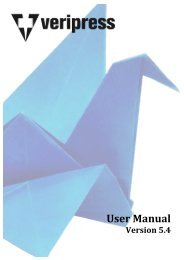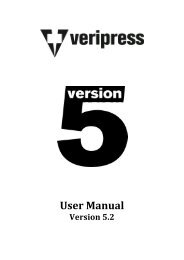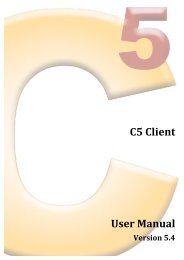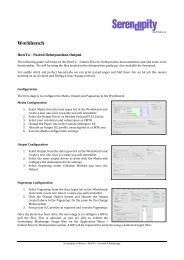Version 5.3.02 - Serendipity Software
Version 5.3.02 - Serendipity Software
Version 5.3.02 - Serendipity Software
Create successful ePaper yourself
Turn your PDF publications into a flip-book with our unique Google optimized e-Paper software.
Context Menu Options <br />
The following are available via the contextual menu (right click) from within the job Display panel: <br />
• Edit RIP – This enables the user to edit the RIP selected. Choose to edit a single section or all sections of the <br />
configuration. Alternatively, you can create a new RIP. <br />
• Colour Scheme – Choose a colour for the module. <br />
• Font Options – Choose the preferred font size. <br />
• Language Encoding – Choose the language encoding for the operating system. This allows jobs to display <br />
correctly in the RIPMonitor in the native language. <br />
Display Panel View Options <br />
The display panel columns can be configured to show specific information by right-‐clicking on the header titlebar. The <br />
following are available for display: <br />
• Name – Job Name (and plate names if expanded). <br />
• Size – The size of the job (disk space used). <br />
• Date – The data and time the newest plate belonging to the job was RIPped. <br />
• Path – The directory path to the RIPped file for an assigned job plate. This information is visible when the <br />
polled job is expanded. <br />
• Publication – The publication name. <br />
• Section – The section of the publication. <br />
• Page – The page number of the job. <br />
ServerLog <br />
The ServerLog shows messages from the Server. <br />
• Fetch back log – Displays the log for the time specified. For <br />
e.g., it retrieves and displays the last 4 hours of messages. <br />
Choose the time period from the pull down list. <br />
• Trim older lines – Trims the log based on the time selected <br />
in Fetch back log. If this is set to 60 minutes, the log file is <br />
trimmed back so only the last 60 minutes remain. <br />
• Export – Export the log to a file. Selecting this displays a window with further options as detailed below: <br />
o Destination File – Choose the filename and location where the file is to be saved. Use the Browse <br />
button to navigate to your preferred location. <br />
o Message Lines – Choose to save all messages in the log window or only those that are highlighted. This <br />
way you can save just a few lines if desired. <br />
o Format – Choose the format to save the file in, either html or plain text. The plain text file is saved with <br />
tab characters between the columns. <br />
o Cancel – Revert to the Server window without saving any changes. <br />
o Save – Save the file based on the settings selected. <br />
• Configure Filter – You can filter messages in the log. Choose between the following options: <br />
o Completed Jobs – Shows messages about completed jobs. <br />
o Polled Jobs – Shows messages about polled jobs. <br />
o Errors – Shows errors from the Server. <br />
• Search – You can search the log for messages. Enter the text of characters you want to search for and the <br />
ServerLog will only display the lines matching the search. <br />
Display Options <br />
• Module – This is the function that the Server used. <br />
• Routine – This is the operation inside the function. <br />
• Date – The time the Server called the module. <br />
• Message – The message resulting from the routine. <br />
<strong>Serendipity</strong> <strong>Software</strong> -‐ Veripress User Manual – <strong>Version</strong> <strong>5.3.02</strong> <br />
70












